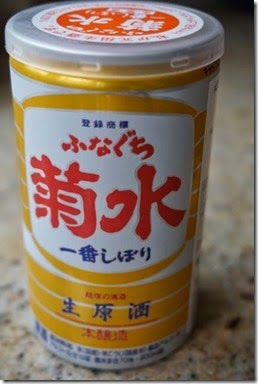Thursday, March 19, 2020
Six "otoshi" appetizers お通し6種類
The upper row from left to right are Chinese-style squid salad (store-bought) with my sugar snap in salt broth, grilled fish cake (store bought) with blanched broccolini dressed in mustard soy sauce, Russian marinated salmon (leftover from the previous evening). (It had been marinading for 2 days by then). The lower row from left to right are octopus leg, cucumber slices and Campari tomato dressed in sumiso sauce and "mizuna" oshitashi 水菜のお浸しtopped with bonito flakes.
Although it missed the group picture, the sixth appetizer was; salmon sashimi and avocado cubes dressed in soy sauce, sesame oil, chiffonade of perilla and finely chopped garlic. The salmon was leftover from the prior evening. I made a slight modification by salting one side and searing it with a kitchen torch before cutting it into cubes. This added an additional grilled flavor and slight crusty texture.
The dish shown below is Chinese-style squid salad 中華風イカサラダ bought at our Japanese grocery store. The variation of this appears to be available at Catalina offshore products as well.
Below is a small deep fried fish cake which is almost always available at our Japanese grocery store. This appears to be locally made and is pretty good. We heat it up in the toaster oven. I dressed blanched broccolini florets with mustard soy sauce (I now make several Japanese sauces in small squeeze bottles and store them in the refrigerator for instant use).
This was leftover Russian marinaded salmon I made the night before. This marinaded a total of 2 days and was almost completely "chemically" cooked but the onion was better now (marinating just overnight, the sweet onion was a bit too raw). I topped this with salmon roe and garnished it with perilla.
The dish below came about due to a mistake I made. I thought I got a bunch of edible chrysanthemum 春菊 but instead it was Japanese mizuna 水菜. I blanched it very quickly for 20 seconds, drained and cooled it down by fanning and squeezed out the moisture (I did this in the morning and kept it in a Ziploc bag in the fridge.) I made this to "ohitashi" お浸し("hitasu" in Japanese is to "soak", I made the sauce with equal parts Japanese dashi and concentrated noodle sauce and "soaked" the mizuna) and topped it with bonito flakes. My wife preferred edible chrysanthemum but this was different and nice in its own right.
We still had the tip portion of the octopus leg left over. I just cut it up into small chunks and mixed the pieces with vinegared cucumber slices and quartered Campari tomato and dressed in sumiso (from the squeeze bottle I prepared earlier).
So with the help of store-bought and leftover items from the previous evening, I finally made a set of 6 appetizer to start the evening--mission accomplished!
Sunday, February 20, 2011
Octopus "butsu-giri" in miso-vinegar sauce 鮹のぶつ切りのからし酢みそ和え
The "drunken" grape tomatoes (smaller than cherry tomato) were leftovers. I made them based on a recipe called "Bloody Mary" on a stick by Frugal gourmet. The original recipe calls for soaking the tomatoes in Vodka but I did not have any. So instead, I soaked the tomatoes in gin with dry vermouth making them "martini" on a stick. Here is the recipe; I skinned the grape tomatoes (by blanching). Then put them in a container of "martini" and left them to enjoy themselves in the fridge for several days. I served them with a small mound of kosher salt on the side and toothpicks to dip them into the salt. The end product has a nice gin flavor and the tomato is sweet. It is a very nice dish. We particularly like the burst of flavor when we bite down on them. Of course, one of us has to drink up the marinade when we finish all the tomatoes (hardship!).
Finally, octopus with miso-vinegar dressing. I just used an end piece of boiled octopus leg. "Butsu-giri" ぶつ切り means simply "cut into chunks". By cutting this way, it has a different texture than when it is thinly sliced. I just used my usual "Karashi sumiso" からし酢みそ made of saikyo miso 西京味噌(2 tbs), Japanese hot mustard (1/2 tsp from a tube), rice vinegar (1 tbs). I added mirin to adjust the thickness and sweetness of the sauce.
Saturday, March 28, 2015
“Cup” sake Funagichi Kikusui ふなぐち菊水生原酒
There is a class of sake called "Cup-sake" which comes in either a glass or aluminum "cup" (about 1 go size 一合 or 180-200ml) with a pull top. These are widely available in convenience stores and vending machines in Japan. This type of sake is usually not high quality but it is easy to get and you can consume it anytime anywhere which appeals to certain clientele. Ozeki 大関 sake brewery is credited for inventing this type of sake (called "One cup Ozeki" ワンカップ大関) in 1964. More recently, better quality sake, even daiginjou 大吟醸 class is being sold in this format but when I lived in Japan, "cup sake" had some negative stigma attached to the extent that even in my youth I did not partake.
Interestingly, when we went to Sakamai 酒舞 in New York some years ago, one of the "genshu" 原酒 tasting included this "Funaguchi Kikusui" ふなぐち菊水生原酒. We did not think it was a particularly great sake but not bad either. We were a bit surprised that this came in an aluminum cup and was included in the "genshu" tasting at this “fancy” sake bar. Later, I learned that Kikusui sake brewery 菊水酒造 was in Niigata 新潟 and there were four different kinds of cup sake including "ginjo" class but this particular one is "hon jouzou" 本醸造 made of rice polished to 70%. "Nama genshu" 生原酒 implies non-pasteurized and non-diluted sake but I am not sure if it was pasteurized after placing it in the can.
In any case, when we had this at Yuzu restaurant the other evening. Few days later, I happened to spot this sake-in-a-can at the Japanese grocery store. I had to buy it to taste it. I served this cold.
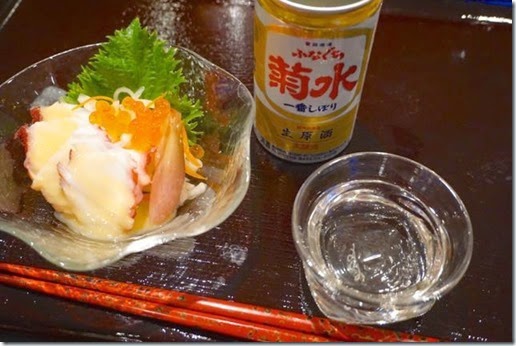
It is always important to me that we taste sake with the appropriate food. I served daikon namasu 大根なます garnished with ikura いくら salmon roe, boiled octopus leg with karashi sumiso 芥子酢味噌and my pickled myouga 茗荷の酢漬.
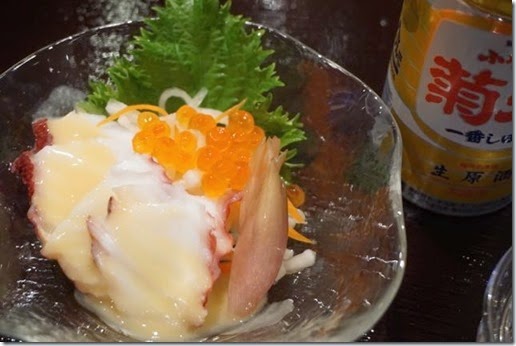
The taste of the sake was totally different from what we had at Yuzu. It has some yeasty flavor of honjouzou but had a nice "umami" flavor and not extremely dry. Although this is not one of our favorites, it is certainly a drinkable sake.
Sunday, November 30, 2014
Frozen fatty tuna from "Fish-for-Sushi" 冷凍大トロ
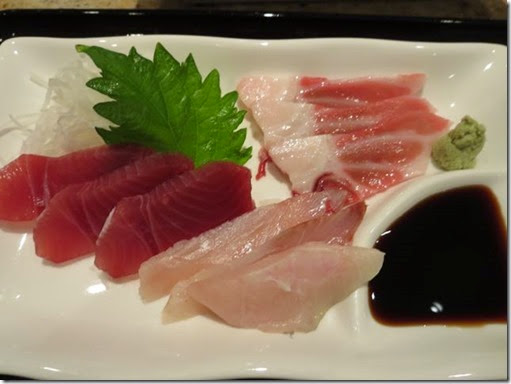
As you can see, this otoro had a large potion of pure fat attached which was a bit chewy; this was not the best otoro.
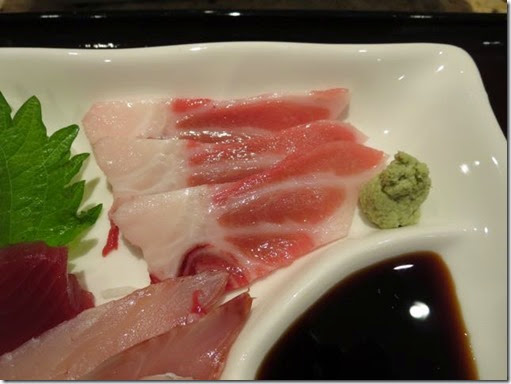
The picture below shows how the frozen sashimi was packaged. The upper right is akami tuna, below that is kanpachi, and upper left encased in a separate container is otoro.

The next picture was taken after the fish were thawed (following the instructions in the packages). To my surprise, the otoro block still had skin attached as well as a large amount of "pure" fat (see below).
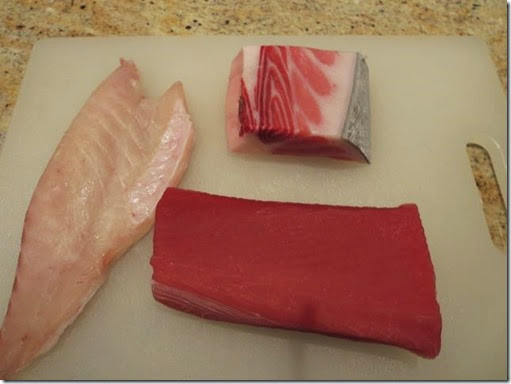
The package said this was aqua cultured and from Japan. The portion is very small to begin with. Once you removed the skin and fat it was even smaller. Paying the otoro price per pound, the inclusion of the unusable skin and less than desirable fat made the useable meat from this piece very expensive (much more expensive than having toro at Tako Grill per unit weight). When my wife saw what had to be discarded she said her grandmother had an expression for this type of situation; “butcher putting a finger on the scale.” We could at least eat the fatty part (I haven’t come up with a recipe for tuna skin yet, however). I suspected the fat would be chewy, so I sliced it into rather thin pieces of otoro with the fat attached and served.
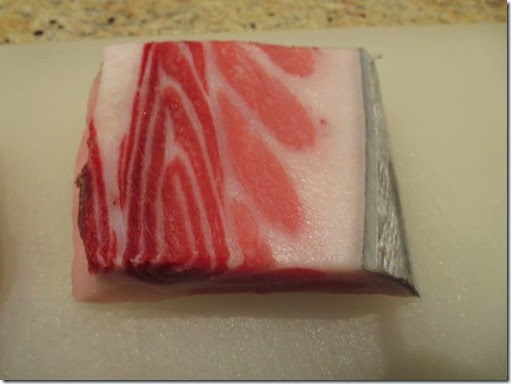
Next day, I removed the pure fat portions, cut it into small cubes and dressed the "karshi sumiso" sauce からし酢味噌 with chopped scallion. It was much better eating the otoro and fat separately than in the same piece as I had done the previous day. These otoro pieces don’t look anything like what was depicted on the "Fish-for-Sushi" web site. Nine ounces at $65 sounded like a good price but once the large portion of pure fat and skin are factored in, this is not a good buy.
Wednesday, July 17, 2019
Italian-style squid salad イタリアンカラマリサラダ
The base green is our home grown arugula. It was getting a bit tough but it has so much flavor even without any dressing. I let the squid marinade for several hours in the refrigerator before serving.
This must have been the next day. I just made it to our usual sumiso 酢味噌 dressed Japanese-style salad with cucumber and wakame seaweed.
Ingredients (this will be 4 servings for us as a small appetizer).
• 2/3 lb cleaned squid
• 1 tablespoons fresh lemon juice
• 1/2 tablespoon red-wine vinegar (I used balsamic vinegar)
• 1/4 cup extra-virgin olive oil
• 1 large garlic clove, minced
• salt and black pepper to taste
• 1/4 sweet (Vidalia) onion, halved lengthwise, then thinly sliced crosswise
• 1/4 cup pitted Kalamata olives, halved lengthwise
• Skinned Campari tomatoes (4-5), halved or quartered if large
• 1 celery ribs, cut into 1/4-inch-thick slices
• Parsley, several sprigs, stem removed, chopped
Preparation of squid:
Rinse squid under cold running water. Halve tentacles lengthwise and cut bodies crosswise into 1/3-inch-wide rings.
Cook squid in a boiling salted water with a splash of sake, uncovered, until just opaque, 40 to 60 seconds. Drain in a colander and immediately transfer to a bowl of ice and cold water to stop the cooking. When squid is cool, drain and pat dry.
Directions for salad:
Whisk together lemon juice, vinegar, oil, garlic, salt, and pepper in a small bowl, then stir in onion, squid, olives, tomatoes, celery, and parsley in a large bowl. Toss with dressing and season with salt and pepper. Let stand at least 15 minutes to allow flavors to develop (I refrigerated for several hours).
Both preparations were good. The Italian-style has more complex flavors with a burst of saltiness when you bite into the olive. For this we choose to have American brewed G-sake on the rocks.
Tuesday, March 10, 2020
Salmon sashimi three ways 鮭の刺身3種
The picture below shows straight salmon sashimi with my usual sugar snap in salted broth スナップ豌豆の塩びたし shown on the right.
The below is a new and very simple dish which I read about somewhere online. I just marinated the salmon sashimi in "shio ko-ji" 塩麹 for a few hours in the refrigerator. I served it topped with "ikura" salmon roe and garnished with chopped chives. The shio ko-ji made the salmon sashimi softer but added a bit slippery surface texture. This is certainly different and not bad but not our favorite way of serving salmon sashimi.
The picture below shows salmon cured overnight in Russian marinade 鮭のロシア漬け. Since the salmon is marinated only overnight, just the surface of the salmon pieces are chemically cooked but the center is still raw. This partial curing is possible because this is sashimi grade salmon. If I made this dish from regular salmon filet, I would make sure the center was opaque indicating that it was completely chemically cooked. I garnished this with a chiffonade of perilla leaves. We liked this preparation very much. To the left of the salmon is a salad of thinly sliced cucumber in sushi vinegar 胡瓜の酢の物 and sliced Campari tomato. On the right side is blanched broccolini dressed with mustard soy sauce.
Since we had boiled octopus leg from the Japanese grocery store, I served it with sumiso dressing as usual.
We really enjoyed this medley of salmon dishes but luckily there was still a small piece of salmon left to look forward to the next evening.
Wednesday, November 23, 2011
Octopus with tomato and olive イタリア風 たこ、トマト、黒オリーブ煮
 In a small skillet, I added olive oil (3 tbs) on low flame and added the garlic, red pepper flakes and slowly cooked it until the garlic became fragrant and very slightly brown. I added the tomatoes, chopped black olive, salt, and pepper. I turned up the heat to medium and cooked for 2-3 minutes (This is not really a tomato sauce). I then added slices of octopus and cooked for 30 more seconds or just until warm--not really cooking it further. I cut the heat and tasted it. I adjusted the seasoning by adding salt and a pinch of sugar since I thought it was a bit on the acidic side. I was thinking of adding lemon juice but changed my mind and only added grated lemon zest (using a micrograter) to give it a lemony flavor. I garnished with chopped parsley (If I had fresh thyme, I may have used thyme). My wife quickly toasted some bread (store bought semolina bread) for mopping up the juice.
In a small skillet, I added olive oil (3 tbs) on low flame and added the garlic, red pepper flakes and slowly cooked it until the garlic became fragrant and very slightly brown. I added the tomatoes, chopped black olive, salt, and pepper. I turned up the heat to medium and cooked for 2-3 minutes (This is not really a tomato sauce). I then added slices of octopus and cooked for 30 more seconds or just until warm--not really cooking it further. I cut the heat and tasted it. I adjusted the seasoning by adding salt and a pinch of sugar since I thought it was a bit on the acidic side. I was thinking of adding lemon juice but changed my mind and only added grated lemon zest (using a micrograter) to give it a lemony flavor. I garnished with chopped parsley (If I had fresh thyme, I may have used thyme). My wife quickly toasted some bread (store bought semolina bread) for mopping up the juice. Friday, September 23, 2022
Lox and Ikura "donburi" bowl 燻製鮭ロックスとイクラ丼
After making Philly rolls, I used the left over lox from Vital Choice to make a donburi for lunch. I made the lunch in the form of a Japanese meal set or "teishoku" 定食. I served the lox/ikura donburi with miso soup made with wakame ワカメ, abura-age 油揚げ and scallion as well as cucumber asazuke 胡瓜の浅漬け
Friday, October 28, 2011
Tuna and Salmon roe 'yamakake" 鮪といくらのやまかけ
Friday, February 4, 2022
Uni appetizers two kinds 雲丹の前菜2種
As I mentioned previously, Maruhide 丸秀 is the best place to get consistently high-quality uni and uni products. I wanted to get some fresh uni for the New Year. Although I checked the web site regularly fresh uni was not available for some time. So when I saw it became available recently, I could not resist and ordered fresh uni (both regular and in salt water or "Kaisui-uni" 海水うに). I also ordered some "uni shuto " ウニ酒盗 which is preserved and frozen and lasts longer than fresh uni. This is second best (compared to fresh uni) but among the class of "preserved" uni, this is the best by far. We had an uni tasting the evening the uni arrived. It consisted of regular uni and uni in salt water. We also included some ikura like we did before. We finished the evening with a small uni and ikura "donburi" rice bowl 雲丹いくら丼.
The next evening, I made a small uni appetizer dish. Although it is hard to see in the picture, I put cubes of avocado dressed in lemon juice in the bottom of the bowl then topped them with uni, "kinshi-ran" 金糸卵 golden thread egg and nori strips or "kizami-nori" 刻み海苔. I added wasabi-jouyu わさび醤油 (mixture of wasabi and soy sauce just before serving). Since the texure of avocado resembles fatty tuna sashimi, this combination went very well together. The avocado really complemented the uni.
Thursday, January 9, 2014
Whole boiled octopus ゆでだこ
*The actual frozen items came from "Uoriki Fresh" located in New Jersey. This place appears to be the wholesaler for the “Fish for Sushi” retail site—or so we assume.
A whole, 2 lb octopus, however, is a lot of octopus, (the usual lamb roast that we buy is only about 3 pounds). So in addition to the portions being used for the New Year's dishes, we had a lot of octopus-eating to do. I had to come up with a number of different dishes in a race against time to finish it up before it went bad. The first day we received it, I made my usual octopus dressed in "karashi-sumiso" as seen below.

I added chopped scallion and thinly julienned daikon.

Another variation I served on a different day was dressed with yuzu-koshou, olive oil and soy sauce. This was rather good with some heat, yuzu citrus flavor.

This is how the whole boiled octopus looked. I defrosted it in the refrigerator for 2 days and washed it under the running cold water.

I separated the legs (eight of them, just in case you did not know "Octo" is 8).

One leg was sliced and then placed in sweet vinegar to make "Sudako" which I used to accompany my daikon "namasu" 大根なます for the New Year (below).

Rejuvination process: The octopus tasted good and fresh but the 3rd day after I thawed it, I re-boiled it to remove any off flavors and to make it last longer. I boiled enough water so that 2-3 legs could be submerged easily with a dash of sake and a small amount of salt. I also prepared a large bowl with ice and cold water next to it. I first placed the 2-3 legs at a time into rapidly boiling water for 5 seconds and then immediately plunged them into the ice water to cool. I repeated this process for all the legs and the head. After they were thoroughly iced down, I removed them from the ice water and patted dry with a paper towel. I wrapped them in a new paper towel and placed them in a Ziploc bag. I refrigerated the pieces in the meat drawer of the refrigerator (lowest temperature place in our refrigerator). With this treatment, I expected the octopus to last at least another week. After tasting it again I think that although it was very good and fresh, after the parboiling, it tasted even better. I made more dishes from this fellow and they will be the subject of separate posts.
Saturday, June 11, 2016
Octopus carpaccio variation タコのカルパッチョ
 We had this with Louis M. Martini Cabernet Sauvignon Napa Valley 2012, this is a very reliable California Cab and got 90 from Wine Advocate. This winery was bought out by the Gallo some years ago but appears to be maintaining their quality. It may not be a spectacular wine but it has all the good qualities of a Napa cab. One should be careful when buying this brand, however, since they make three different versions with near-identical labels but different prices; they are from Napa, Alexander and Sonoma valleys. We tried all three in different vintages but we liked the Napa version best. This wine went rather well with the carpaccio, although the addition of fish roe resulted in a somewhat less than perfect match for red wine. The roe were in small enough amounts so as not to be objectionable and they did add a nice saltiness. The balsamic vinegar was more sweet than vinegary and did not compete with this red. The olive oil was again great, adding nice fruity, grassy tastes with a peppery finish. The octopus itself had a very neutral flavor (an euphemism for not much taste) but added great texture. We had the octopus slices with layers of the onion, cucumber which made it very nice. I made one more dish which we had with this red wine before changing to cold sake with tuna tartar (both dishes are subjects of future posts).
We had this with Louis M. Martini Cabernet Sauvignon Napa Valley 2012, this is a very reliable California Cab and got 90 from Wine Advocate. This winery was bought out by the Gallo some years ago but appears to be maintaining their quality. It may not be a spectacular wine but it has all the good qualities of a Napa cab. One should be careful when buying this brand, however, since they make three different versions with near-identical labels but different prices; they are from Napa, Alexander and Sonoma valleys. We tried all three in different vintages but we liked the Napa version best. This wine went rather well with the carpaccio, although the addition of fish roe resulted in a somewhat less than perfect match for red wine. The roe were in small enough amounts so as not to be objectionable and they did add a nice saltiness. The balsamic vinegar was more sweet than vinegary and did not compete with this red. The olive oil was again great, adding nice fruity, grassy tastes with a peppery finish. The octopus itself had a very neutral flavor (an euphemism for not much taste) but added great texture. We had the octopus slices with layers of the onion, cucumber which made it very nice. I made one more dish which we had with this red wine before changing to cold sake with tuna tartar (both dishes are subjects of future posts). Monday, October 17, 2022
Octopus leg dressed in salted plum sauce タコの梅肉あえ
I have posted many dishes using octopus which we got from different sources. We like octopus legs (boiled and frozen) from D’artagnan and Great Alaska Seafood. Interestingly, both are “Spanish octopus legs”. The offer we recently purchased from Great Alaska Seafood included quite a large amount of octopus legs so I have the luxury of using it fairly regularly. The last time I used it, after thawing, I reserved about 2 inches of the octopus leg to eat as “sashimi*” 刺身 and I made the remainder into tender simmered octopus タコの柔らか煮 using an Instant pot. We usually eat octopus sashimi with wasabi and soy sauce or sumiso but this time, I tried a different dressing using salted plum or “Umeboshi” 梅干し (I used some umeboshi we received quite a few years ago from my mother the last time she made it. We kept it in a sealed container in the refrigerator. It looked and tasted good). I also served two small appetizer dishes.
*Most common “sashimi” of octopus is previously boiled legs because raw octopus is extremely perishable. Real “raw” octopus can be had in Japan. The first time we had “raw” octopus sashimi was in Kobe 神戸 many years ago. Because of the location of Kobe, very fresh octopus from the Japanese inland sea 瀬戸内海 was available. Now, because of the advancement in the logistics of transporting fresh seafood in Japan, it is more readily available throughout Japan. As a matter of fact, we had raw octopus sashimi at Tako Grill in Kuroishi 黒石, Aomori prefecture 青森県 in Japan.
Sunday, August 31, 2014
“Raw” scattered sushi 生ちらし
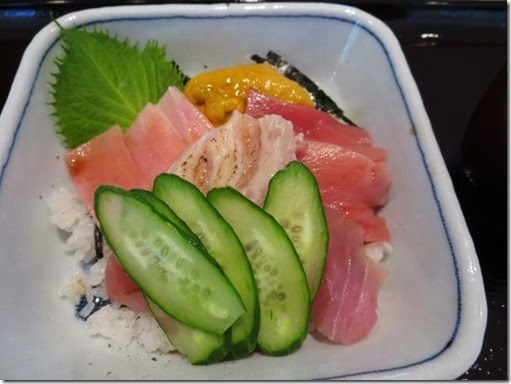
The slices of cucumber are genuine Japanese cucumber (not American mini-cucumber) and tasted better. I served this with miso soup (tofu, nameko mushroom).

Sushi rice: This was made from imported Koshihikari コシヒカリrice from Niigata, Japan (subject for another post). I seasoned it with sushi vinegar from the bottle.
Topping: All the pieces came from a toro block I purchased from Catalina. This toro block did not have any chiai 血合い. #1(in the picture below) is the pure fat just underneath the skin. This time I left a layer a few millimeters thick on the skin and then removed it as a single layer. I cut it into rectangles. #2 is the more traditional fatty portion or Ootro. I salted it and then torched it with my handy kitchen flame-thrower (no kitchen should be without it) to make "aburi" 炙り. #3 is medium fatty tuna or Chu-toro 中トロ. #4 is wild caught hamachi which was fairly lean rather than oily. #5 is uni and the slices of cucumber are Japanese cucumber I got from our Japanese grocery store.
I made a rather thin layer of sushi rice, covered it with thin strips of dried nori and put the sashimi and cucumber on top. I happened to have Sashimi-jouyu* 刺身醤油 I made several days ago and painted it on each piece of sashimi with a brush. I served wasabi and additional sashimi-jouyu on the side.
* Sashimi-jouyu: You can buy this special type of soy sauce in a bottle or make it yourself. There are many variations. The most famous is "Tosa-jouyu" 土佐醤油. I used soy sauce, mirin, and sake (2:1:1) ratio and added about equal amounts of broth made from shaved dried bonito flakes or katsuo-dashi カツオ出し. I then simmered the mixture for 10-15 minutes until the amount reduced to 2/3. I placed this in a sealable jar in the refrigerator. The amount of each ingredient can be adjusted to your liking. Instead of bonito broth, you could use water (to make it "pure" soy sauce flavor). You could also use much less mirin and sake or even add sugar.
The pure fat layer was particularly good. Usually, this layer is very firm. I cut it into small cubes and dressed it in " sumiso" sauce but this time the layer was not too firm and melted in your mouth. This was a rather decadent lunch and we even had a bit of cold sake.








